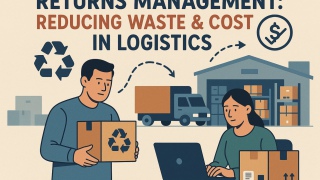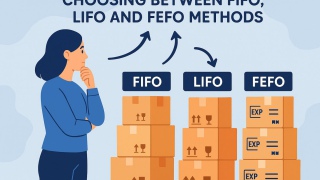Last Mile Logistics: Optimizing the Final Delivery Step

The "last mile" in logistics refers to the final leg of a product’s journey, from a distribution center or hub to the customer’s doorstep. While it might seem like the shortest distance, it’s often the most complex, expensive, and time-consuming part of the entire logistics chain. In today's e-commerce driven world, where customer expectations for speed and convenience are at an all-time high, optimizing the last mile delivery has become a critical differentiator for businesses across various industries.
Why is the Last Mile So Challenging?
The inherent difficulties of last mile logistics stem from a confluence of factors:
-
Geographical Dispersion: Deliveries often involve navigating dense urban areas with heavy traffic, limited parking, and intricate street layouts, or sprawling rural areas with long distances between stops.
-
Customer Expectations: Consumers now expect rapid, often same-day or next-day, delivery with precise time windows. They also demand real-time tracking and flexible options for receiving packages.
-
High Costs: The sheer number of individual stops, coupled with fuel consumption, vehicle maintenance, labor costs, and potential failed deliveries, makes the last mile disproportionately expensive. Estimates suggest it can account for over 50% of total shipping costs.
-
Environmental Concerns: Increased traffic and emissions from numerous delivery vehicles contribute to urban pollution and congestion, leading to a demand for more sustainable delivery optimization strategies.
-
Unpredictability: Traffic jams, weather conditions, customer unavailability, and unexpected road closures can all disrupt delivery schedules, leading to delays and inefficiencies.
The Imperative for Last Mile Optimization
Given these challenges, why is last mile optimization so crucial?
-
Enhanced Customer Satisfaction: A smooth and efficient final delivery experience directly impacts customer loyalty and repeat business. Failed or delayed deliveries can lead to frustration and lost sales.
-
Cost Reduction: Even marginal improvements in efficiency, such as reducing fuel consumption or minimizing failed deliveries, can lead to significant cost savings at scale.
-
Competitive Advantage: Businesses that can consistently offer faster, more reliable, and more flexible last mile delivery options gain a distinct edge over competitors.
-
Sustainability: Optimizing routes and exploring alternative delivery methods can help reduce carbon footprints and align with corporate social responsibility goals.
-
Scalability: As e-commerce continues to grow, efficient last mile operations are essential to handle increasing volumes without compromising service quality.
Strategies for Last Mile Delivery Optimization
Optimizing the last mile is not a one-size-fits-all solution; it requires a multi-faceted approach leveraging technology, strategic planning, and innovative solutions.
1. Advanced Route Optimization Software
Gone are the days of manual route planning. Modern last mile logistics heavily relies on sophisticated delivery optimization software. These platforms utilize algorithms to:
-
Generate optimal routes: Considering factors like traffic, delivery windows, vehicle capacity, and driver availability.
-
Dynamic rerouting: Adapting to real-time changes such as new orders, cancellations, or unexpected delays.
-
Multi-stop planning: Efficiently sequencing multiple deliveries to minimize travel time and distance.
-
Proof of delivery: Capturing electronic signatures, photos, or GPS coordinates to confirm successful deliveries.
2. Real-Time Tracking and Communication
Transparency is key to managing customer expectations. Implementing real-time tracking allows customers to monitor their package's journey, reducing "where is my order?" inquiries. This also enables proactive communication, alerting customers to potential delays or changes in delivery times. Drivers can also communicate directly with customers for specific instructions or to resolve issues.
3. Diversifying Delivery Methods
Relying solely on traditional vans for last mile delivery might not always be the most efficient or sustainable approach. Businesses are exploring alternatives:
-
Micro-fulfillment Centers (MFCs): Smaller urban warehouses positioned closer to customers reduce the distance goods need to travel.
-
Click-and-Collect/BOPIS (Buy Online, Pick Up In Store): Customers pick up orders at a convenient retail location, shifting the last mile responsibility.
-
Automated Delivery Vehicles: Drones and autonomous robots are being piloted for specific types of deliveries, especially in low-density areas or for specific items.
-
Bicycle/E-bike Couriers: Ideal for dense urban environments, offering faster transit through traffic and reduced environmental impact.
-
Crowdsourced Delivery: Utilizing a network of independent contractors for on-demand deliveries, providing flexibility and scalability.
4. Data Analytics and Predictive Modeling
Leveraging data collected from past deliveries, customer behavior, and traffic patterns can provide invaluable insights for optimizing future operations. Predictive analytics can forecast demand, identify peak delivery times, and anticipate potential bottlenecks, allowing for proactive resource allocation.
5. Efficient Warehouse and Sortation Processes
The efficiency of the last mile begins long before the package leaves the distribution center. Streamlined picking, packing, and sortation processes are crucial to ensure orders are accurately prepared and loaded for optimal routing. Cross-docking strategies can also minimize storage time and expedite outbound shipments.
6. Driver Training and Empowerment
Well-trained drivers are integral to successful last mile delivery. Training should cover not only safe driving practices but also customer service skills, efficient loading/unloading techniques, and effective use of delivery optimization technology. Empowering drivers with the right tools and information can significantly improve their efficiency and job satisfaction.
7. Returns Management
The last mile isn't just about outbound delivery; it also encompasses returns. An efficient reverse logistics process for customer returns is essential. Simplifying the return process for customers and having clear procedures for collecting and processing returned items can enhance overall satisfaction and reduce costs.
The Future of Last Mile Logistics
The landscape of last mile logistics is continuously evolving, driven by technological advancements and shifting consumer demands. We can expect to see:
-
Increased Automation: From autonomous vehicles to automated sorting facilities, automation will play an even larger role in streamlining operations.
-
Hyper-personalization: Customers will demand even greater control over their deliveries, including highly precise time windows and personalized communication.
-
Sustainable Solutions: A greater emphasis on electric vehicles, drone deliveries, and other eco-friendly methods will be crucial to address environmental concerns.
-
Collaboration and Partnerships: Businesses may increasingly collaborate on last mile delivery to share resources and reduce costs.
-
Data-Driven Decision Making: The use of AI and machine learning will become even more sophisticated, enabling real-time optimization and predictive capabilities.
Conclusion
Last mile logistics is no longer just an operational necessity; it's a strategic imperative for businesses aiming to thrive in the competitive e-commerce landscape. By embracing technological innovations, adopting flexible delivery models, and prioritizing customer experience, companies can effectively overcome the challenges of the final delivery step, achieving significant cost savings, enhancing customer satisfaction, and building a sustainable competitive advantage. Optimizing the last mile is not just about moving goods; it's about delivering promises.
_0x70_d59.png)



